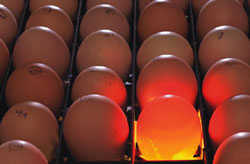



To Candle or Not to Candle
The reasons for candling and practical tips from Gerd de Lange of Pas Reform.During the incubation process, eggs are candled to determine the number of infertile eggs and eggs with dead embryos, together indicated as ‘clears’. This can be done as early as day 5 or 6 of incubation by an individual candling light but it is time-consuming – and the risk of candling errors (e.g. accidentally removal of an egg with a normal living embryo) is evident.
 |
The risk for candling errors is reduced if candling is performed on day 9 or 10 of incubation. By this time, it is also possible to use a so-called ‘candling table’, whereby the entire setter tray is illuminated from beneath. Using a candling table is less time consuming than using an individual candling light, though at the expense of accuracy. Because when the number of ‘clears’ is high, light escaping through the empty places – or ‘flooding’ – in the setter tray makes it more difficult to identify remaining clears conclusively. In many hatcheries, it is therefore common practice to candle eggs on the day of transfer to the hatcher, as this is most efficient in terms of time and labour productivity. When eggs are checked in this way at the point of transfer, automatic candling equipment that illuminates all eggs before the clears are removed, may be used without the disadvantage of reduced accuracy by light flooding.
There are several reasons for candling
- Early detection of problems on breeder farms, during egg handling and incubation, especially if combined with egg break-out.
- Creating a set of hatchery specific reference data, in combination with egg break-out.
- Estimation of expected percentage viable chicks.
- Reduction of hatchery waste. In some cases, clears have a market value, whereas take-off fees are incurred for waste handling unhatched eggs.
- Positive impacts on hatchability and chick quality.
For reasons 1-3, it is sufficient to candle a representative number of eggs set. For reasons 4 and 5, all eggs should be candled and clears removed.
The work of Reis et al (1993) showed improved chick quality as a consequence of clear egg removal during candling, especially with older flocks. Studies by Embrex Inc. (International Hatchery Practice, 17 (7)) also favour the removal of clear eggs during transfer and prior to in ovo vaccination. This trend appears to be stronger in the case of older flocks – a factor also supported by the results of Pas Reform Academy’s work with customers in the field – and by experienced hatchery managers.
Clear eggs transferred to the hatcher create an unstable climate in the hatcher baskets, because they do not produce metabolic heat. When automatic chick separators are used, clear eggs are liable to break, causing ‘painted’ chicks.
Advice
- Do not candle between 11 and 14 days of incubation, as it interrupts the movement of the embryo to the length axis of the egg.
- When candling on day 9 or 10, empty places on the setter tray should be filled up by moving the remaining eggs backwards to create complete rows, leaving the first rows empty.
- Remove clears when higher than 10 to 15 per cent. When the percentage of clears is lower than 10 per cent, there is no direct need to remove clears prior to transfer.
- If during candling at day of transfer more than 30 eggs are removed from a setter tray with 150 eggs, add eggs from another tray to ensure each hatcher basket is full. Ideally, eggs should touch each other while laying in the hatcher basket; it seems the vibrations caused by first chicks to pip are a trigger for other chicks to start pipping as well.
- Record the number of clears and consider running an egg break-out on a representative sample.
July 2011








